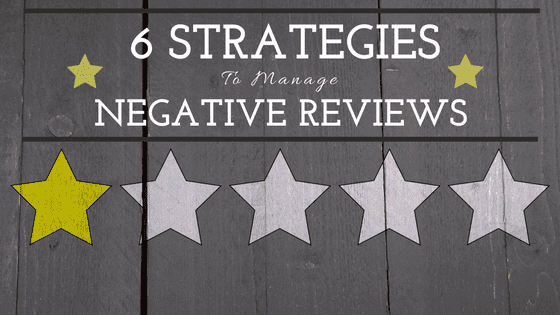6 Strategies to Manage Negative Reviews
How to Manage Negative Reviews
No business owner wants to see a bad review about their company online. In a world where consumers trust online reviews almost as much as they do recommendations from friends and family, anyone doing research on your company or products is likely to see that negative review.
Recently, a friend was looking to purchase new appliances for his home. Before visiting a store or even asking friends and family for advice, he went online to check out reviews. His experience looking at reviews is probably similar to what yours or mine would be. He read a few reviews for different products, was wary of products that had only 5-star ratings, and trusted products that had a couple of negative reviews (with a good overall rating).
His reasoning? “Every product has its issues. I don’t want to buy anything that has undiscovered problems”.
Jackpot.
A company with only 5-star reviews comes across as fake or untrustworthy to the public.
Too many negative reviews are indicative of a poorly-made product, and star ratings are the first judgment customers make when doing product research. There’s a balance that has to be found between positive and negative feedback.
68% of consumers trust online reviews more if there are both positive and negative reviews, yet 86% are hesitant to purchase from a business that has negative reviews.
Contradictory and frustrating, huh? This indicates that while negative reviews make the experiences of your customers more believable, having an excess number of negative reviews or unresolved negative reviews can have a damaging impact on your online reputation. So, while a few negative reviews seem necessary to make your brand or product credible, proper management of these reviews can lessen their negative impact on sales.
So how can you manage negative reviews?
1. Be Openly Responsive
Try to respond to negative reviews directly on the site where those reviews were posted. Some review companies might not allow you to respond, but if they do, it’s well worth your time to do so. These companies aren’t going to delete customer reviews (unless you can prove that they were fake or untrue, which is very difficult to do), so in many cases, your responses are your only saving grace.
Expect that if a customer has left a bad review on one site, they’ve left it on multiple. Check all of the major review sites like Yelp, Foursquare, Angie’s List, and Yahoo, as well as social media pages, and respond anywhere there are negative reviews, even if it’s a review or customer you’ve already responded to on another site. You’ll want to do this for two reasons. First, make sure that anyone seeing those reviews knows that you are taking corrective actions. Not everybody visits every site, so being responsive on each site ensures maximum visibility regarding your intentions to make it right. Second, the customer that left a negative review is more likely to see it and respond. Don’t simply respond though. Use this to actually fix the problem and make the customer happy.
2. Reach Out Directly
Whenever possible, try to reach out to the customer directly or ask them to contact you. If you collected contact information from the customer and you know who left the review, or you have some other means of contacting them directly, you can reach out to the customer personally to try to resolve the issue.
If they left a bad review on social media, you can give them an email address or phone number to reach out to as soon as possible to get the problem fixed. Not only could this personal touch make the customer feel warm and fuzzy because they’re perceiving that you care, but reaching out directly to them may make them more likely to respond to you and allows you to diffuse the situation. Once the issue is resolved, ask them to update their bad review with their new, positive experience. A bad review turned good is one of the best types of reviews you can possibly have.
3. Respond to Threats
If a customer is threatening to leave a negative review because of a bad experience, you should be bending over backward to prevent that. While initially, you may take a small hit to your pride, you’re ultimately protecting your bottom line and online reputation, which can save you thousands of dollars in potential lost sales. And, if they still end up posting the negative review, you then have a great response to help to neutralize their feedback.
4. Highlight the Positives
If your company has a blog or a website (and it definitely should!) then create a review page using the keywords “review”, “reviews”, your company name, and other keywords related to your business. Through SEO and continual updates with unique content, push this page to the top of search engine results, and use it to highlight positive experiences your customers have had with you.
5. Ask for Reviews
Actively ask for reviews from your customers, or hire a company that will ask your customers for unbiased reviews. The good experiences will far outweigh the bad and decrease the impact that any negative reviews will have. When you actively solicit reviews from your customers, you will collect significantly more reviews and have a much higher star rating that more accurately reflects your company’s true reputation! Hiring a third-party company to do this is completely legal and ethical and can help to repair your reputation.
Learn more about active reviews here!
6. Give Upset Customers a Resolution Path
The #1 reason why upset customers leave negative reviews on 3rd party websites is that they couldn’t find a way to get help from the business they made their purchase. The best way to stop customers from leaving negative reviews on other sites is to give them resolution paths after the sale. The easiest way to do this is with a follow-up email or a phone call to ask them about their experience. By giving them one or more easily accessible resolution paths, they’ll be much more likely to reach out to you if a problem arises, and you can address their issues long before they escalate.
In the world today it’s inevitable - your company will receive negative reviews. However, by following the 6 strategies above, you should be able to manage any negative reviews you come across, and in many cases, be able to turn those reviews into positive experiences for new potential customers who find them. It all depends on how you look at the reviews and how you respond to them.
Related posts on managing reviews


 Drive More Visibility, Traffic, and Sales
Drive More Visibility, Traffic, and Sales
